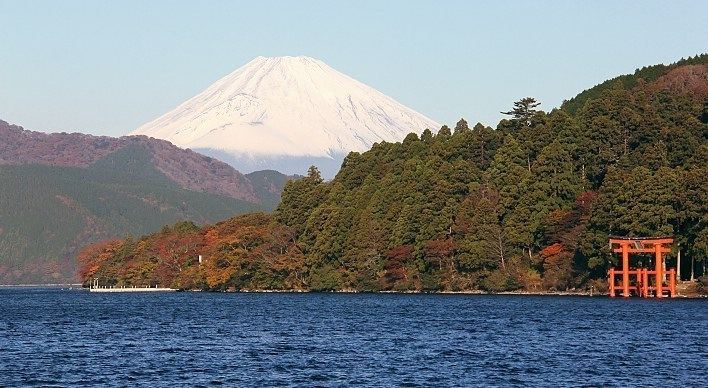Region Kantō Local time Wednesday 8:46 AM | ||
 | ||
- Tree Yamazakura (Prunus jamasakura) - Flower Hakonebara (Rosa microphylla hirtura) Weather 3°C, Wind NW at 21 km/h, 67% Humidity Points of interest Lake Ashi, Ōwakudani, Hakone Open‑Air Museum, Hakone Ropeway, Hakone Shrine | ||
Travel in japan lake ashinoko hakone
Hakone (箱根町, Hakone-machi) is a town in Ashigarashimo District in Kanagawa Prefecture, Japan. As of June 2012, the town had an estimated population of 13,492 and a population density of 145 persons per km². The total area was 92.82 km². Hakone has been designated as a Geopark by UNESCO.
Contents
- Travel in japan lake ashinoko hakone
- Map of Hakone Ashigarashimo District Kanagawa Prefecture Japan
- Geography
- Surrounding municipalities
- History
- Economy
- Railway
- Highways
- Sister cities
- References
Map of Hakone, Ashigarashimo District, Kanagawa Prefecture, Japan
Geography
Hakone is located in the mountainous far west of the prefecture, on the eastern side of Hakone Pass. Most of the town is within the borders of the volcanically active Fuji-Hakone-Izu National Park, centered on Lake Ashi.
Surrounding municipalities
Kanagawa Prefecture
Shizuoka Prefecture
History
Hakone is the location of a noted Shinto shrine, the Hakone Gongen, which is mentioned in Heian period literature. During the Genpei War, Minamoto no Yoritomo prayed at this shrine for victory over his enemies, after his defeat at the Battle of Ishibashiyama, which was fought in neighboring Manazuru. As with the rest of Sagami Province, the area came under the control of the late Hōjō clan of Odawara during the Sengoku period. After the start of the Edo period, Hakone-juku was a post station on the Tōkaidō highway connecting Edo with Kyoto. It was also the site of a major barrier and official checkpoint on the route known as the Hakone Checkpoint (箱根関所, Hakone sekisho), which formed the border of the Kantō region. Under the Tokugawa shogunate, all travellers entering and leaving Edo along the Tōkaidō were stopped here by officials. Their travel permits and baggage were examined to enforce Tokugawa laws that restricted the travel of women and weapons.
After the start of the Meiji Restoration, Hakone became a part of the short-lived Ashigara Prefecture before becoming part of Ashigarashimo District in Kanagawa prefecture in August 1876. Hakone attained town status in 1889. The imperial household established the summer Hakone Imperial Villa close to the lake.
After merger with five neighboring towns and villages in September 1956, it reached its present boundaries.
Economy
The economy of Hakone is strongly dominated by the tourist industry. Hakone is noted for its onsen hot spring resorts, which attract both Japanese and international visitors due to its proximity to the greater Tokyo metropolis and to Mount Fuji. Sights include the volcanically active Owakudani geysers and Hakone Shrine on the shore of the lake, as well as the Hakone Botanical Garden of Wetlands. In April the cherry blossoms (sakura) and in autumn the Miscanthus sinensis (susuki) are noted sights.
Hakone has a number of art museums, including the Hakone Open-Air Museum and Pola Museum of Art.
Major events include the annual Hakone Ekiden, a long distance collegiate foot race, held at the New Year, which runs from Tokyo to Hakone and back over two days, partly in commemoration of the couriers who ran the Tōkaidō road.
One famous hotel in Hakone is the historic Fujiya Hotel in Miyanoshita, which was patronized by noted literary figures, politicians and foreign dignitaries in the Meiji and Taishō and early Shōwa periods.
A noted local handicraft is parquetry.
Railway
Hakone is best accessed from Odawara and Mishima, the terminus of the Odakyū Odawara Line, 70 minutes from Shinjuku, Tokyo. From Odawara, the Hakone Tozan Line continues into various resort towns in Hakone. Odakyu also runs the Romancecar limited express between Shinjuku and Hakone-Yumoto. From Gōra, the terminus of Hakone Tozan Line, the Hakone Tozan Cable Car funicular goes to Sōunzan. Ōwakudani can be reached by Hakone Ropeway from Sounzan and the lake, while the lake is crisscrossed by cartoonishly decorated "pirate" ships for tourists. There is also Hakone Komagatake Ropeway, which goes to the top of Mount Komagatake.
A popular "Hakone Free Pass", allowing unlimited use of most forms of transport for several days, is available. Hakone Free Pass can be bought at Shinjuku Station, Odawara Station, any other chief station along Odakyū Odawara Line, Hakone-Yumoto Station, Gōra Station, any other chief station along Hakone Tozan Line, Sōunzan Station, Tōgendai Station, Sengoku-Annaijo Bus Stop, Moto-Hakone Port, Hakone-Machi Port, and JR Gotemba Station Bus Information.
